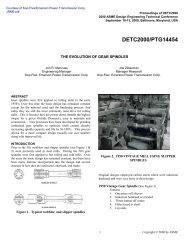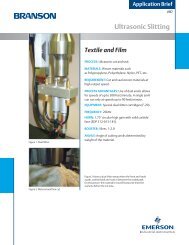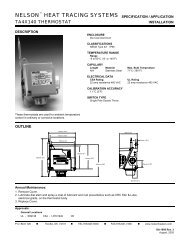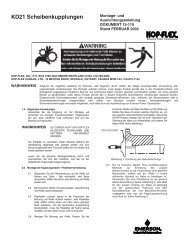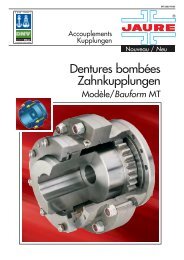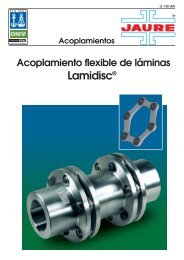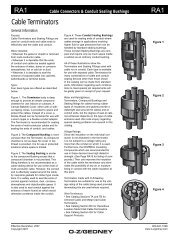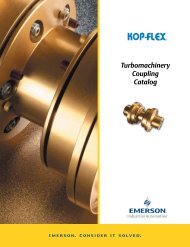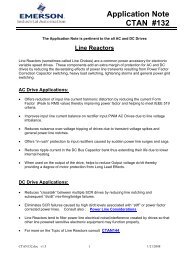- Page 1 and 2:
Industrial Products Couplings Catal
- Page 3 and 4:
COUPLINGS ® INTRODUCTION Overview
- Page 5 and 6:
® LUBRICATED COUPLINGS (Cont'd). K
- Page 7 and 8:
How to Select A Coupling GEAR Advan
- Page 9 and 10:
KD ® Disc Couplings Size 053 throu
- Page 11 and 12:
Selection Procedure 1. Coupling Sty
- Page 13 and 14:
KD ® Disc Couplings Dynamic Balanc
- Page 15 and 16:
Flexible Disc Couplings Product Ove
- Page 17 and 18:
KD ® Slide Disc Couplings Coupling
- Page 19 and 20:
Selection Data Size ¬ Data based o
- Page 21 and 22:
Selection Data À Data based on max
- Page 23 and 24:
Selection Data KD ® Disc Couplings
- Page 25 and 26:
Selection Data Size Maximum Bores (
- Page 27 and 28:
Selection Data KD ® Disc Couplings
- Page 29 and 30:
Selection Data Size Max. Bore (in)
- Page 31 and 32:
The KD4 coupling is designed for me
- Page 33 and 34:
Selection Data ¬ Data for two flex
- Page 35 and 36:
Selection Data KD ® Disc Couplings
- Page 37 and 38:
KD ® Disc Couplings KD42S Slide Fl
- Page 39 and 40:
"L" Jaw Type Couplings Jaw Hub (Ste
- Page 41 and 42:
"L" Jaw Type Couplings C C A E A D
- Page 43 and 44:
"J" Jaw Type Couplings Table No. 1
- Page 45 and 46:
RESILIENT COUPLINGS Non-Lubricated
- Page 47 and 48:
Max-C ® Resilient Couplings Rigid
- Page 49 and 50:
Values listed are intended only as
- Page 51 and 52:
MAX-C ® Resilient Couplings Coupli
- Page 53 and 54:
MAX-C ® Resilient Couplings Type K
- Page 55 and 56:
MAX-C ® Resilient Couplings Type K
- Page 57 and 58:
MAX-C ® Resilient Couplings Type C
- Page 59 and 60:
MAX-C ® Resilient Couplings Type C
- Page 61 and 62:
(1) SERVICE FACTORS: MAX-C ® Resil
- Page 63 and 64:
MORFLEX ® COUPLINGS The MORFLEX ®
- Page 65 and 66:
MORFLEX ® Couplings Coupling Comme
- Page 67 and 68:
MORFLEX ® Couplings Principle THE
- Page 69 and 70:
MORFLEX ® Couplings Double or “C
- Page 71 and 72:
Elastomeric Couplings A Proven and
- Page 73 and 74:
Elastomeric Couplings A Proven and
- Page 75 and 76:
Elastomeric Couplings Selection Pro
- Page 77 and 78:
1. See opposite table for dimension
- Page 79 and 80:
Elastomeric Couplings Type DO Dimen
- Page 81 and 82:
Elastomeric Couplings Spacer Coupli
- Page 83 and 84:
Mill motor Couplings are for use on
- Page 85 and 86:
Delrin* Chain Couplings Coupling Fe
- Page 87 and 88:
Delrin* Chain Couplings N400 Series
- Page 89 and 90:
Delrin* Chain Couplings Selection a
- Page 91 and 92:
EVER-FLEX Couplings EVER-FLEX FEATU
- Page 93 and 94:
EVER-FLEX Couplings Table No. 2 Cou
- Page 95 and 96:
Rigid Couplings BUSHED TYPE RIGID C
- Page 97 and 98:
Fast’s ® Gear Couplings Size 1 1
- Page 99 and 100:
Fast’s ® Gear Couplings The Fast
- Page 101 and 102:
Fast’s ® Gear Couplings Selectio
- Page 103 and 104:
Fast’s ® Gear Couplings Full Fle
- Page 105 and 106:
Fast’s ® Gear Couplings Spacer C
- Page 107 and 108:
Fast’s ® Gear Couplings AISE Mil
- Page 109 and 110:
Fast’s ® Gear Couplings Limited
- Page 111 and 112:
When driving and driven shafts are
- Page 113 and 114:
The Fast’s ® Long Slide coupling
- Page 115 and 116:
Fast’s ® Gear Couplings Type SH
- Page 117 and 118:
Fast’s ® Gear Couplings Continuo
- Page 119 and 120:
Fast’s ® Gear Couplings Extra Lo
- Page 121 and 122:
Fast’s ® Vertical Single Engagem
- Page 123 and 124:
Fast’s ® Brake Wheel Couplings T
- Page 125 and 126:
A conventional 4-bearing system has
- Page 127 and 128:
Series H Gear Couplings Size 1 thro
- Page 129 and 130:
Series H Gear Couplings Series H co
- Page 131 and 132:
1. Select Coupling Based on Bore Ca
- Page 133 and 134:
Series H Gear Couplings Full Flex C
- Page 135 and 136:
Standard Spacer Couplings Series H
- Page 137 and 138:
Series H Gear Couplings Flex Rigid
- Page 139 and 140:
Series H Gear Couplings AISE Mill M
- Page 141 and 142:
Series H Gear Couplings Slide Coupl
- Page 143 and 144:
Series H Brake Disc couplings use s
- Page 145 and 146:
Alloy Steel Series H spacer couplin
- Page 147 and 148:
Torque Overload Release Couplings S
- Page 149 and 150:
Series H Shear Pin Cartridge Coupli
- Page 151 and 152:
DATA REQUIRED WITH THE ORDER 1. Siz
- Page 153 and 154:
Series HSPS Shear Pin Spacer Coupli
- Page 155 and 156:
Series HSPX Shear Pin Floating-Shaf
- Page 157 and 158:
Fast’s ® Breaking Pin Type FBP T
- Page 159 and 160:
Waldron ® Flexalign ® Gear Coupli
- Page 161 and 162:
Waldron ® Gear Couplings FULL ENGA
- Page 163 and 164:
1. Select Coupling Based on Bore Ca
- Page 165 and 166:
Standard Spacer Couplings Full-flex
- Page 167 and 168:
For sleeve bearing motor applicatio
- Page 169 and 170:
Waldron ® Gear Couplings Taper-Loc
- Page 171 and 172:
TURBOMACHINERY COUPLINGS HIGH PERFO
- Page 173 and 174:
Syn-Tech 3913G Grease Gear Spindle
- Page 175 and 176:
Gear Spindles Paper Machine Couplin
- Page 177 and 178:
Gear Spindles PM Series (Paper Mach
- Page 179 and 180:
KOP-GRID ® Tapered Grid Couplings
- Page 181 and 182:
Kop-Grid ® Couplings T10 T10 with
- Page 183 and 184:
1. Coupling Type: Select the approp
- Page 185 and 186:
Kop-Grid ® Couplings Table No. 1 S
- Page 187 and 188:
Type T10 & T20 Grid Hub Bore Capaci
- Page 189 and 190:
Chain Couplings Index: Page Covers
- Page 191 and 192:
DRC Chain Couplings Horsepower Rati
- Page 193 and 194:
TURBOMACHINERY COUPLINGS HIGH PERFO
- Page 195 and 196:
Gear Spindles Ranging From 4 - 1/16
- Page 197 and 198:
Each of the three possible heat tre
- Page 199 and 200:
Design Gear spindles are available
- Page 201 and 202:
Gear Spindles Improved Contact Grou
- Page 203 and 204:
ME Series (Mill Element, seal on Hu
- Page 205 and 206:
MB Series (Mill Basic, seal on Hub)
- Page 207 and 208:
Axial Travel for Vertical Roll/Stan
- Page 209 and 210:
Thrust Button on Center Line of Gea
- Page 211 and 212:
Roll End Bore Designs Gear Spindles
- Page 213 and 214:
Gear Spindles Troubleshooting and R
- Page 215 and 216: Gear Spindles Circulating Oil Spind
- Page 217 and 218: Custom-Tailored Inventory and Maint
- Page 219 and 220: Additional Features: • Replaceabl
- Page 221 and 222: Why Kop-Flex ® Brand Couplings?
- Page 223 and 224: Gear Spindles SL Series - 6° level
- Page 225 and 226: FLANGED UNIVERSAL JOINTS • In Sto
- Page 227 and 228: Flanged Universal Joints Features a
- Page 229 and 230: Flanged Universal Joint Part Number
- Page 231 and 232: Flanged Universal Joints Selection
- Page 233 and 234: 40° Flanged Universal Joints ULS (
- Page 235 and 236: Flanged Universal Joints ULDT (Ligh
- Page 237 and 238: Flanged Universal Joints ULDF (Ligh
- Page 239 and 240: Flanged Universal Joints ULDS (Ligh
- Page 241 and 242: 45° M Flanged Universal Joints UMD
- Page 243 and 244: 45° M Flanged Universal Joints UMK
- Page 245 and 246: G L Flanged Universal Joints Rigid
- Page 247 and 248: Flanged Universal Joints Cross & Be
- Page 249 and 250: Flanged Universal Joints Repair Ser
- Page 251 and 252: Coupling Comments Where to Look for
- Page 253 and 254: FOR STEEL, ALUMINUM, COPPER AND BRA
- Page 255 and 256: MAXXUS ® Universal Joints Selectio
- Page 257 and 258: MAXXUS ® Universal Joints Design O
- Page 259 and 260: TURBOMACHINERY COUPLINGS HIGH PERFO
- Page 261 and 262: Barrel Couplings Type TCB Type TCB-
- Page 263 and 264: Barrel Couplings Parts Lists Fig. 3
- Page 265: Barrel Couplings Description and Ch
- Page 269 and 270: 2.1. CALCULATION OF RADIAL LOAD Bar
- Page 271 and 272: Thus, the transmission torque T is:
- Page 273 and 274: d2 Barrel Couplings Diameters and p
- Page 275 and 276: Barrel Couplings Diameters and para
- Page 277 and 278: Barrel Couplings Wear Indicator One
- Page 279 and 280: Finished Bore Dimensions Standard C
- Page 281 and 282: General Information A GUIDE TO NEMA
- Page 283 and 284: Coupling Part Number Reference Part
- Page 285 and 286: Coupling Part Number Reference Part
- Page 287 and 288: Coupling Part Number Reference FAST
- Page 289 and 290: Coupling Part Number Reference Part
- Page 291 and 292: Coupling Part Number Reference Part
- Page 293 and 294: Coupling Part Number Reference KD1,
- Page 295 and 296: Coupling Part Number Reference Part
- Page 297 and 298: Coupling Part Number Reference Part
- Page 299 and 300: Alpha-Numerical Index A AL40 - AL10
- Page 301 and 302: Alpha-Numerical Index 103 KD 1 SS F
- Page 303 and 304: TURBOMACHINERY COUPLINGS HIGH PERFO
- Page 305 and 306: Experience the Power of Edge Online





